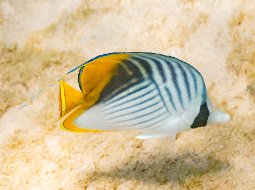
Loading Aqualapp ...
Care and Compatibility of Surgeonfish - Paracanthurus hepatus
Introduction
The surgeonfish, or Paracanthurus hepatus, is a popular marine fish in aquariums. It is known for its vibrant colors, especially the bright blue and yellow tail. These fish are called 'surgeons' because of the sharp spines on both sides of their caudal fin, resembling surgical scalpels. Although these spines can be used in defense, they are generally peaceful and active swimmers.
Behavior
The surgeonfish, also known as Paracanthurus hepatus, is known for its active and generally peaceful behavior in aquariums. These fish are popular for their vibrant colors and their ability to clean aquariums of algae.
Sexual Dimorphism
Sexual dimorphism in Paracanthurus hepatus is minimal and difficult to distinguish. Both sexes have a similar appearance.
Reproduction
The reproduction of surgeonfish in aquariums is challenging due to their territorial behavior and the lack of information about their reproduction in captivity. Most surgeonfish available in the trade are captured in the wild.
Aquarium Conditions
Paracanthurus hepatus, commonly known as the blue tang, requires a spacious aquarium with plenty of room to swim. It prefers warm and well-oxygenated water. Aquarium décor should include rocks and caves to provide shelter. Maintaining water quality is crucial and providing a varied diet.
Feeding
As for feeding, surgeonfish are primarily herbivores. They feed on algae and plant matter in the wild. In captivity, they can be fed with commercial herbivorous fish foods and algae. It is also beneficial to offer them fresh foods such as spirulina and nori algae.
Complexity
Caring for Paracanthurus hepatus can be moderately challenging. They are territorial fish and can be aggressive with other tangs in a smaller aquarium. It's recommended to keep them in larger groups or in a well-stocked reef tank. They are herbivores and accept a variety of plant-based foods.
In case you need more help, or if you want to know into any topic related to the Paracanthurus hepatus (Surgeonfish) and even any other species you can use the forums to ask what you need.
To do an analysis more detailed about coexistence and behavior of Paracanthurus hepatus (Surgeonfish) use the Aquarium simulation tool, if you do this you can test different ways to combine the Surgeonfish with other fishes giving the dimensions and space on you aquarium, on this way you can known the optimal configuration for keep the fishes that you want.
You can also find out the 4 species compatible with the Paracanthurus hepatus (Surgeonfish) can live together.
Note: The parameters of the water such as PH and temperature are also used to calculate the compatibility of the species.
Compatible species (4)
No species is compatible with the Surgeonfish, however, 4 fish are semi compatible with the Surgeonfish with certain conditions special.
With Reservation (3 Species)
The compatibility among surgeonfish in an aquarium can vary depending on the specific species, tank size, and layout. While many surgeonfish are generally peaceful, some may become territorially aggressive, particularly towards others of the same or similar species. It is advisable to introduce surgeonfish of different species simultaneously and in sufficiently large tanks to allow them to establish their own territories without excessive competition for space or resources. Monitoring behavior and being prepared to intervene in case of excessive aggression is crucial. Compatibility among surgeonfish can vary, and the diversity of species and individual personalities should be considered when keeping them together in an aquarium.
Compatibility between surgeonfish and clownfish in an aquarium can depend on various factors such as tank size, the availability of hiding spots, and the individual personalities of each fish. Surgeonfish are generally peaceful, but some can become territorial or aggressive, especially in smaller tanks or when there is limited decor to provide shelter. Clownfish, on the other hand, may exhibit social hierarchy and territorial behavior. Introducing these species gradually and monitoring their behavior is crucial. Providing ample space, hiding spots, and maintaining a group of clownfish can help distribute potential aggression. However, each aquarium is unique, and closely observing the interaction between these fish is important, being prepared to take action if compatibility issues arise.
Surgeonfish, or tangs, are not typically associated with anemones in the same way as clownfish. While tangs can peacefully coexist with anemones in a reef environment, they usually don't form the same symbiotic relationship. Some tang species may swim near or among the tentacles of anemones without causing harm, but caution is needed. Tangs may graze on algae within the tank and should not be introduced solely for the purpose of interacting with anemones. Anemones should be chosen and placed with consideration for the specific needs of the tang species in the aquarium.
Compatible if space is enough (1 Species)
They can coexist together if the aquarium they share is large and spacious enough for both species to feel good, as some fish may attack others to feel that they have little space and try to eliminate the competition.
Surgeonfish
Paracanthurus hepatus

- Ph: 8.1 - 8.4
- Temperature (c°): 24 - 28
- Measures: 20 cm - 40cm
- Aquarium Capacity:
60 Liters - 16 Gallons - Alimentación: Omnivores
- Colores: Black, Blue, Yellow
- Comportamiento: Active, Peaceful, Sociable
- Habitad: Indo-Pacific (Coral reefs)
- Morfología: Bright colors, Thorns or pointed
- Preferencias del Acuario: Coral reef
- Tamaño: Big
- Taxonomía: Fish
- Tipo de Agua: Saltwater
- Velocidad de nado o movimiento: Fast
- Zona de Nado: Swim in the middle of the aquarium



